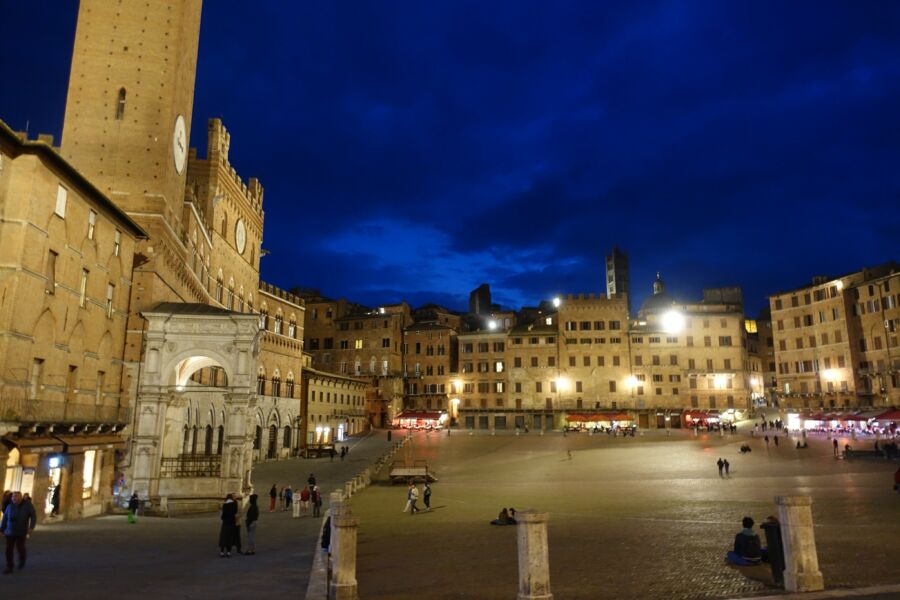
I think a regular dose of travel daydreaming can be good for the soul. Fly discreetly with me to Siena, Italy in this excerpt from my book For the Love of Europe , a collection of 100 favorite places, people and stories from European travelers.
Siena, perched on a Tuscan hilltop, offers perhaps the best experience of medieval Italy. Yards have wells adorned with flowers, churches modestly share their art, and alleys end with stunning views of red-tiled rooftops. This is a city made for walking. With its rocky skyline and winding streets that wind in all directions, the city is an architectural detour through time dominated by pedestrians and the present recalling the past.
Today, the self-assured people of Siena proudly recall their centuries-old accomplishments. In the 13th century AD, Siena was one of the largest cities in Europe and a major military power, along with Florence, Venice and Genoa. But Siena was weakened by a catastrophic epidemic and overrun by her Florentine rivals, and has been a stagnant region ever since. The loss of Siena was a gain for the traveler, as its political and economic importance retained its Gothic identity.
This is the most striking thing about Il Campo, from where I start my walk. In the center of the city, this large shell-shaped square, with a sloping red brick floor facing the town hall tower, is intended for people and invites to stroll. Il Campo immerses you in a world where metropolitans play guitars, lovers stroke their hair, and bellies become pillows. I got my vote for the best pitch in all of Europe.
Most Italian cities have a church in the main square, but Il Campo gathers the people of Siena around the town hall with its skyscraper. I caught my breath after climbing to the top of the 100-meter bell tower, admiring the view and thinking about the statement made by the bell tower. In Siena, kings and popes took precedence over the people, as did secular government, civil society, and humanity.
We greet the public at the town hall, where for seven centuries the illustrative frescoes have reminded of all traces of government, good and bad. The fresco depicts a utopian republic living in peace; Another fresco depicts a city in ruins, conquered by greed and tyranny.
But the church still has its place. If Il Campo is the heart of Siena, then the Duomo is its soul and my next destination. A few blocks from the main square, above Siena's highest point and visible for miles around, this dark green and white striped cathedral is as ornate as it is gothic. Inside and outside it is decorated with statues and mosaics. The stone heads replicate an almost 2,000-year gap (over 170 to date) inside, looking down on everyone who enters.
Large works of art, including sculpted statues by Michelangelo and Bernini, fill the interior of the chapel. The magnificent marble pulpit was created in 1268 by Nicola Pisano. It is filled with subtle gothic narratives. I go to study scenes from the life of Christ and the Last Judgment.
Trying to escape from the crowds in the cathedral and the main square, I ventured out of the city center. I deliberately get lost in the intriguing streets of Siena, dotted with rings of iron horses and hung with colorful flags. These flags symbolize the rivalry (districts) of the city, whose fierce loyalty is apparently shown twice each summer during the Palio, a wild horse race that turns the Campo into an exciting and crowded hippodrome.
When I venture into the city limits, I enjoy Sienese delicacies from roadside stalls: gourmet pasta, aged Chianti, wild boar prosciutto, and the city's favorite dish: panforte.
Panforte is Sienna's claim to calorie fame. This rich and moist mixture of nuts, honey and candied fruits will impress even fruitcake lovers. Local bakeries claim that their recipe dates back to the 13th century. Some even have employees sign non-disclosure agreements to ensure they don't reveal the special spice mix that spices up their version of this very dense and beloved cake.
One of the keys to enjoying Siena is to imagine it at its peak in the 14th century while enjoying today's modern landscape. After chewing a piece of panforte, I decided to stay here until the evening, after the tour groups boarded their buses and left the city. I went to the bar for happy hour, which includes a free buffet, and now I'm up and ready to join the evening passeggiata . It is time for me to return to Il Campo to enjoy that beautiful moment of twilight when the sky is a dark blue dome, no brighter than the proud towers of Siena that they seem to keep in the air.
